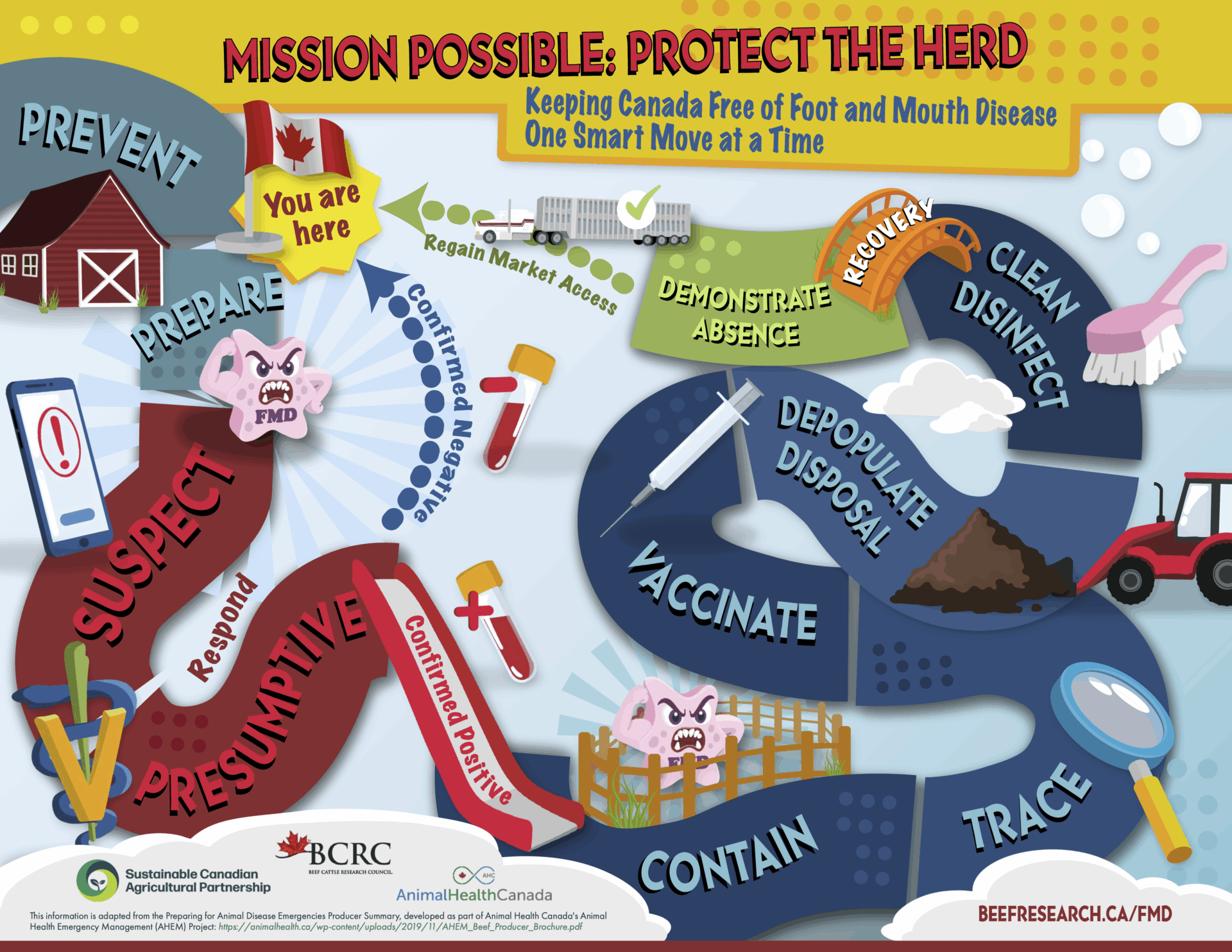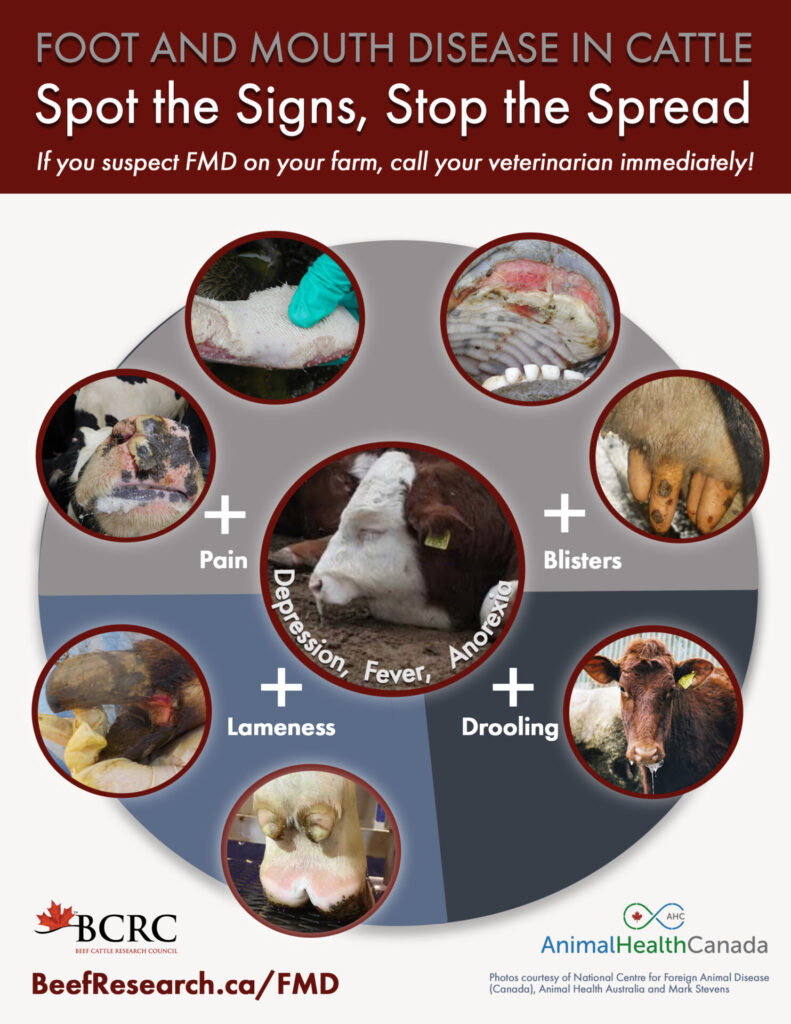YOU ARE HERE -- Beef Producers Have a Game Plan to Keep Canada FMD-Free
Canada’s last outbreak of Foot and Mouth Disease (FMD) occurred in Saskatchewan in 1952, and, since then our herds have remained free of FMD. According to the World Organisation for Animal Health, Canada is designated as FMD-free without vaccination. This designation is awarded to countries that do not have the FMD virus circulating among cloven-hoofed animals without regular preventative vaccines.
The 1952 outbreak was traced to contaminated clothing and/or a single sausage brought over by a farm worker from Germany. This seemingly harmless act of bringing soiled clothing or a foreign food product had devastating effects on the Canadian economy, costing approximately $722 million in expenses and lost revenue at that time. If an outbreak were to occur in Canada today, it is estimated that the economic impact could soar upwards to $75.8 billion.
Canada’s FMD-free status is not a matter of luck. It has been maintained through decades of dedication to strict import and export regulations, border security and public awareness. Canadian beef producers must remain vigilant, working together to prevent FMD from crossing our borders and being prepared to act swiftly if a suspect case is detected.
Help Keep Canada FMD-Free One Smart Move at a Time











You Are Here! Prevent and Prepare
Canada is currently able to prevent Foot and Mouth Disease from crossing our borders and to prepare for any suspected FMD cases.
- The Canadian livestock industry is currently unaffected by FMD.
- Beef producers must remain aware and continue to take steps to minimize risk of FMD and other diseases.
- Proactive planning, training and implementing biosecurity measures is a key focus.
Suspect
If an unusual animal health event occurs, industry may be asked to remain vigilant and take precautions to minimize serious animal disease risk, which may trigger a presumptive or confirmed positive condition.
- PRESUMPTIVE: If a notice of suspicion is issued by the Canadian Food Inspection Agency (CFIA) or provincial governments, the beef industry may be asked to voluntarily pause non-essential movements on and off farms.
- CONFIRMED POSITIVE: If a positive case of FMD is confirmed by Canada’s Chief Veterinary Officer, Chief Provincial Veterinarian or a federal or provincial Minister, it may trigger CONTAINMENT strategies including movement controls of animals, personnel, products and equipment.
Trace
To mitigate the impact of FMD, effective traceability is essential for disease tracking and control. Traceability requires animal ID, premises ID and movement recording. Producers facilitate an effective response by keeping up-to-date records, registering their premises and implementing traceability options.
- VACCINATE: If FMD were detected in Canada, emergency vaccinations may be ordered to help contain the disease, protect animals and safeguard the industry.
- After vaccination protocols were implemented, the industry would turn towards DEPOPULATION and DISPOSAL of infected animals as well as rigorous CLEANING and DISINFECTING protocols based on guidance from the CFIA and provincial authorities.
Recover
The goal of emergency preparedness and the associated response is to recover from an outbreak and to regain a status of FMD-free without vaccination.
Canadian beef producers and consumers can be confident of this current reality (free of FMD without vaccine) in Canada but being aware that a process exists for immediate action and response if a suspected case should arise, is an important piece in the game.
If you suspect Foot and Mouth Disease on your farm, contact your veterinarian immediately.
“Establishing a dedicated FMD vaccine bank is a vital tool in safeguarding the health of our livestock, market access and the future of our industry. CFIA’s announcement marks a key milestone towards our shared goal of strengthening Canada’s preparedness against the threat of Foot and Mouth Disease. We will continue to work with governments and stakeholders to ensure Canada has a robust emergency preparedness and prevention strategy against FMD.”
– Tyler Fulton, President, Canadian Cattle Association
A collaborative effort between the BCRC and Animal Health Canada (AHC) is currently underway ensuring that prevention and emergency response resources are being tailored specifically to the needs of Canadian beef producers.
Animal Health Canada is a not-for-profit corporation jointly funded by its members, which include federal, provincial and territorial governments, industry organizations and other partners working in animal health and welfare in Canada. AHC works to bring groups within Canada’s livestock industry together to keep Canada’s farms healthy. As an organization that promotes an understanding of the various roles and responsibilities within the livestock industry, they provide resources to ensure preparedness in the case of emergencies.
Sharing or reprinting BCRC posts is welcome and encouraged. Please credit the Beef Cattle Research Council, provide the website address, www.BeefResearch.ca, and let us know you have chosen to share the article by emailing us at [email protected].
Your questions, comments and suggestions are welcome. Contact us directly or spark a public discussion by posting your thoughts below.

